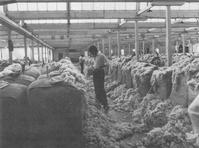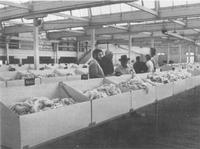


Chapter 5
I 1788 - State Of The Art In Textile Technology
II Australian Textiles - The Early Days
III Australian Textiles - The 20th Century
i Technology and Development
ii Australian Wool Textile Research
IV Australian Textiles - To Date
V Acknowledgements
References
Index
Search
Help
Contact us

Australian Wool Textile Research (continued)
As we will see below, self-twist also stimulated further spinning research in the Division which ultimately led to the development of another new method (Sirospun) of producing worsted weaving yarns of more general advantage than self-twist.The profitability of the many stages up to and including spinning depends on many factors but, above all, perhaps, on the quality of the incoming wool fibre. The purchases made by raw-wool buyers can make or break a company working in early-stage processing, and the quality of their products is critical to the efficiency of subsequent processing and the performance of the ultimate product.
In the 1950s, wool was still sold in the traditional manner (Fig. 21 above). Buyers would open many bales, extract samples by hand, and view and test the product subjectively. The appearance of the crimp and the feel of the wool, for example, would be used in the buyers' assessment of the important property of fibre diameter (micron). A flick of the wool staple with his fingers would tell the buyer whether the fibres were likely to break in carding, and what sort of consequent fibre loss could be expected in combing. Visual assessment only would be used for assessing the amount of clean fibre (yield) after cleaning the wool. It was certainly very fortunate for the industry that buyers probably underestimated as much as they overestimated these factors.
The importance of objective measurement of these properties had been well-recognized, and laboratory test instruments were in existence for some properties, e.g. fibre diameter. However, tests -if they were done at all -were carried out after purchase.
With four to five million bales in the clip and only a short time between shearing and sale, improved sampling techniques and more efficient instrumentation were required for many properties if such testing could be carried out prior to sale on a large scale. Research at the Sydney CSIRO laboratory was aimed at overcoming these problems. The first step lay in the development of a pressure coring machine for taking samples from the bales. Core boring, in which an electrically driven rotating tube with a sharp end is pushed into the bale, had been used for sampling for many years. In 1959, CSIRO researchers developed a pressure-boring tool[27] that could be manually thrust into the bale by one person without any need for rotating the tube. This method was much faster than core boring, and was soon adopted world-wide. The pressure borer made it possible for the first time to envisage large-scale 'core testing' of samples taken from baled wool. Tests were then developed for yield and vegetable content.
Because the best of the overseas processors recognized the economic importance of the knowledge gained from such tests, by 1969 almost a quarter of the clip was being core tested (by the Australian Wool Testing Authority) after sale. By that time, it was clear that changes in wool marketing were needed and a special organisation, the Australian Objective Measurement Project (AOMP), was set up in 1970. All branches of the wool industry were represented, including the AWC, and CSIRO was responsible for providing facilities for the program's research. The objectives were to investigate the technical and organisational aspects of introducing pre-sale testing as an aid to marketing.
The wool buyers who were intermediate between the wool grower and wool processor were naturally loathe to accept that their subjective assessments were not accurate and pointed to the fact that they also assessed other factors, so AOMP developed the idea of 'sale-by-sample':[28] the wool buyer being provided with the results of pre-sale tests that could be carried out on a large scale for yield (in simple terms, the amount of clean wool), vegetable matter content, and average fibre diameter. The test results would be printed in the buyer's catalogue, received before the sale commenced. On the sale-by-sample show floor (Fig. 21 below), rows of boxes were to be laid out at bench height, each holding a display sample made up of a few kilograms of wool drawn from all the bales of a line. Wool buyers would now set their bids using a combination of the test results and a subjective assessment of other characteristics made by sight and handle of the grab samples. There would be no need to transport bales to selling centres, only samples.


Organisations in Australian Science at Work - Australian Objective Measurement Project (A.O.M.P.); Australian Wool Corporation; Australian Wool Testing Authority; CSIRO; CSIRO Division of Textile Physics
 |
Australian Academy of Technological Sciences and Engineering |  |
© 1988 Print Edition pages 285 - 287, Online Edition 2000
Published by Australian Science and Technology Heritage Centre, using the Web Academic Resource Publisher
http://www.austehc.unimelb.edu.au/tia/291.html